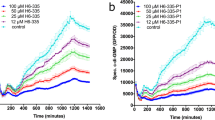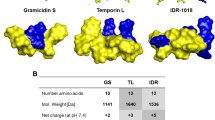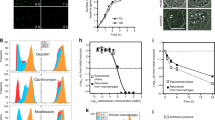Abstract
Chronic infections are difficult to treat with antibiotics but are caused primarily by drug-sensitive pathogens. Dormant persister cells that are tolerant to killing by antibiotics are responsible for this apparent paradox. Persisters are phenotypic variants of normal cells and pathways leading to dormancy are redundant, making it challenging to develop anti-persister compounds. Biofilms shield persisters from the immune system, suggesting that an antibiotic for treating a chronic infection should be able to eradicate the infection on its own. We reasoned that a compound capable of corrupting a target in dormant cells will kill persisters. The acyldepsipeptide antibiotic (ADEP4) has been shown to activate the ClpP protease, resulting in death of growing cells. Here we show that ADEP4-activated ClpP becomes a fairly nonspecific protease and kills persisters by degrading over 400 proteins, forcing cells to self-digest. Null mutants of clpP arise with high probability, but combining ADEP4 with rifampicin produced complete eradication of Staphylococcus aureus biofilms in vitro and in a mouse model of a chronic infection. Our findings indicate a general principle for killing dormant cells—activation and corruption of a target, rather than conventional inhibition. Eradication of a biofilm in an animal model by activating a protease suggests a realistic path towards developing therapies to treat chronic infections.
This is a preview of subscription content, access via your institution
Access options
Subscribe to this journal
Receive 51 print issues and online access
$199.00 per year
only $3.90 per issue
Buy this article
- Purchase on Springer Link
- Instant access to full article PDF
Prices may be subject to local taxes which are calculated during checkout






Similar content being viewed by others
References
Alekshun, M. N. & Levy, S. B. Molecular mechanisms of antibacterial multidrug resistance. Cell 128, 1037–1050 (2007)
Lewis, K. Persister cells. Annu. Rev. Microbiol. 64, 357–372 (2010)
Keren, I., Shah, D., Spoering, A., Kaldalu, N. & Lewis, K. Specialized persister cells and the mechanism of multidrug tolerance in Escherichia coli. J. Bacteriol. 186, 8172–8180 (2004)
Keren, I., Wu, Y., Inocencio, J., Mulcahy, L. R. & Lewis, K. Killing by bactericidal antibiotics does not depend on reactive oxygen species. Science 339, 1213–1216 (2013)
Bigger, J. W. Treatment of staphylococcal infections with penicillin. Lancet 244, 497–500 (1944)
Spoering, A. L. & Lewis, K. Biofilms and planktonic cells of Pseudomonas aeruginosa have similar resistance to killing by antimicrobials. J. Bacteriol. 183, 6746–6751 (2001)
Costerton, J. W., Stewart, P. S. & Greenberg, E. P. Bacterial biofilms: A common cause of persistent infections. Science 284, 1318–1322 (1999)
Kostakioti, M., Hadjifrangiskou, M. & Hultgren, S. J. Bacterial biofilms: development, dispersal, and therapeutic strategies in the dawn of the postantibiotic era. Cold Spring Harb. Perspect. Med. 3, a010306 (2013)
Maisonneuve, E., Shakespeare, L. J., Jorgensen, M. G. & Gerdes, K. Bacterial persistence by RNA endonucleases. Proc. Natl Acad. Sci. USA 108, 13206–13211 (2011)
Moyed, H. S. & Bertrand, K. P. hipA, a newly recognized gene of Escherichia coli K-12 that affects frequency of persistence after inhibition of murein synthesis. J. Bacteriol. 155, 768–775 (1983)
Germain, E., Castro-Roa, D., Zenkin, N. & Gerdes, K. Molecular mechanism of bacterial persistence by HipA. Mol. Cell 52, 248–254 (2013)
Correia, F. F. et al. Kinase activity of overexpressed HipA is required for growth arrest and multidrug tolerance in Escherichia coli. J. Bacteriol. 188, 8360–8367 (2006)
Harrison, J. J. et al. The chromosomal toxin gene yafQ is a determinant of multidrug tolerance for Escherichia coli growing in a biofilm. Antimicrob. Agents Chemother. 53, 2253–2258 (2009)
Maisonneuve, E., Castro-Camargo, M. & Gerdes, K. (p)ppGpp controls bacterial persistence by stochastic induction of toxin-antitoxin activity. Cell 154, 1140–1150 (2013)
Dörr, T., Vulić, M. & Lewis, K. Ciprofloxacin causes persister formation by inducing the TisB toxin in Escherichia coli. PLoS Biol. 8, e1000317 (2010)
Unoson, C. & Wagner, E. A small SOS-induced toxin is targeted against the inner membrane in Escherichia coli. Mol. Microbiol. 70, 258–270 (2008)
Gurnev, P. A., Ortenberg, R., Dorr, T., Lewis, K. & Bezrukov, S. M. Persister-promoting bacterial toxin TisB produces anion-selective pores in planar lipid bilayers. FEBS Lett. 586, 2529–2534 (2012)
Lewis, K. Platforms for antibiotic discovery. Nature Rev. Drug Discov. 12, 371–387 (2013)
Brötz-Oesterhelt, H. et al. Dysregulation of bacterial proteolytic machinery by a new class of antibiotics. Nature Med. 11, 1082–1087 (2005)
Gottesman, S., Roche, E., Zhou, Y. & Sauer, R. T. The ClpXP and ClpAP proteases degrade proteins with carboxy-terminal peptide tails added by the SsrA-tagging system. Genes Dev. 12, 1338–1347 (1998)
Li, D. H. et al. Acyldepsipeptide antibiotics induce the formation of a structured axial channel in ClpP: A model for the ClpX/ClpA-bound state of ClpP. Chem. Biol. 17, 959–969 (2010)
Lee, B. G. et al. Structures of ClpP in complex with acyldepsipeptide antibiotics reveal its activation mechanism. Nature Struct. Mol. Biol. 17, 471–478 (2010)
Kirstein, J. et al. The antibiotic ADEP reprogrammes ClpP, switching it from a regulated to an uncontrolled protease. EMBO Mol. Med. 1, 37–49 (2009)
Michel, K. H. & Kastner, R. E. A54556 antibiotics and process for production thereof. US patent 4,492. 650 (1985)
Sass, P. et al. Antibiotic acyldepsipeptides activate ClpP peptidase to degrade the cell division protein FtsZ. Proc. Natl Acad. Sci. USA 108, 17474–17479 (2011)
Michalik, S. et al. Proteolysis during long-term glucose starvation in Staphylococcus aureus COL. Proteomics 9, 4468–4477 (2009)
Buske, P. J. & Levin, P. A. A flexible C-terminal linker is required for proper FtsZ assembly in vitro and cytokinetic ring formation in vivo. Mol. Microbiol. 89, 249–263 (2013)
Keren, I., Kaldalu, N., Spoering, A., Wang, Y. & Lewis, K. Persister cells and tolerance to antimicrobials. FEMS Microbiol. Lett. 230, 13–18 (2004)
Johnson, P. J. & Levin, B. R. Pharmacodynamics, population dynamics, and the evolution of persistence in Staphylococcus aureus. PLoS Genet. 9, e1003123 (2013)
Frees, D., Qazi, S. N., Hill, P. J. & Ingmer, H. Alternative roles of ClpX and ClpP in Staphylococcus aureus stress tolerance and virulence. Mol. Microbiol. 48, 1565–1578 (2003)
Hussain, M., Hastings, J. G. & White, P. J. A chemically defined medium for slime production by coagulase-negative staphylococci. J. Med. Microbiol. 34, 143–147 (1991)
Stryjewski, M. E. & Chambers, H. F. Skin and soft-tissue infections caused by community-acquired methicillin-resistant Staphylococcus aureus. Clin. Infect. Dis. 46 (Suppl 5). S368–S377 (2008)
Gillaspy, A. F. et al. Role of the accessory gene regulator (agr) in pathogenesis of staphylococcal osteomyelitis. Infect. Immun. 63, 3373–3380 (1995)
Miyazaki, M. et al. Vancomycin bactericidal activity as a predictor of 30-day mortality in patients with methicillin-resistant Staphylococcus aureus bacteremia. Antimicrob. Agents Chemother. 55, 1819–1820 (2011)
Lewis, K. Antibiotics: recover the lost art of drug discovery. Nature 485, 439–440 (2012)
Hung, C. et al. Escherichia coli biofilms have an organized and complex extracellular matrix structure. mBio. 4, e00645–13 (2013)
Vlamakis, H., Chai, Y., Beauregard, P., Losick, R. & Kolter, R. Sticking together: building a biofilm the Bacillus subtilis way. Nature Rev. Microbiol. 11, 157–168 (2013)
LaFleur, M. D., Qi, Q. & Lewis, K. Patients with long-term oral carriage harbor high-persister mutants of Candida albicans. Antimicrob. Agents Chemother. 54, 39–44 (2010)
Mulcahy, L. R., Burns, J. L., Lory, S. & Lewis, K. Emergence of Pseudomonas aeruginosa strains producing high levels of persister cells in patients with cystic fibrosis. J. Bacteriol. 192, 6191–6199 (2010)
Mwangi, M. M. et al. Tracking the in vivo evolution of multidrug resistance in Staphylococcus aureus by whole-genome sequencing. Proc. Natl Acad. Sci. USA 104, 9451–9456 (2007)
Levin, B. R. & Rozen, D. E. Non-inherited antibiotic resistance. Nature Rev. Microbiol. 4, 556–562 (2006)
Howden, B. P. et al. Evolution of multidrug resistance during Staphylococcus aureus infection involves mutation of the essential two component regulator WalKR. PLoS Pathog. 7, e1002359 (2011)
Leung, E. et al. Activators of cylindrical proteases as antimicrobials: identification and development of small molecule activators of ClpP protease. Chem. Biol. 18, 1167–1178 (2011)
Wang, Y. et al. Reversed-phase chromatography with multiple fraction concatenation strategy for proteome profiling of human MCF10A cells. Proteomics 11, 2019–2026 (2011)
Livesay, E. A. et al. Fully automated four-column capillary LC–MS system for maximizing throughput in proteomic analyses. Anal. Chem. 80, 294–302 (2008)
Mayampurath, A. M. et al. DeconMSn: a software tool for accurate parent ion monoisotopic mass determination for tandem mass spectra. Bioinformatics 24, 1021–1023 (2008)
Kim, S. et al. The generating function of CID, ETD, and CID/ETD pairs of tandem mass spectra: applications to database search. Mol. Cell Proteomics 9, 2840–2852 (2010)
Monroe, M. E., Shaw, J. L., Daly, D. S., Adkins, J. N. & Smith, R. D. MASIC: a software program for fast quantitation and flexible visualization of chromatographic profiles from detected LC-MS(/MS) features. Comput. Biol. Chem. 32, 215–217 (2008)
Zuluaga, A. F. et al. Neutropenia induced in outbred mice by a simplified low-dose cyclophosphamide regimen: characterization and applicability to diverse experimental models of infectious diseases. BMC Infect. Dis. 6, 55 (2006)
Blaser, J. In-vitro model for simultaneous simulation of the serum kinetics of two drugs with different half-lives. J. Antimicrob. Chemother. 15. (Suppl A). 125–130 (1985)
Acknowledgements
We thank B. Wright and C. Blinn of AstraZeneca for assisting with the establishment of the mouse infection model, R. E. Lee, M. Pollastri and Z. Maglika for critical discussions and advice, I. Keren and S. Rowe for reading of the manuscript, H. Brewer, V. Petyuk and D. Camp II for assistance with proteomics, and Z. Zheng for assistance with ChemDraw. This work was supported by NIH award T-RO1 AI085585 to K.L., by Arietis Corporation to M.D.L and K.C., by the NIH-NIAID IAA Y1-AI-8401 to J.N.A. and P41 GM103493-11 to R.D.S. Proteomic analysis was performed in the EMSL, a DOE-BER national scientific user facility at Pacific Northwest National Laboratory (PNNL). PNNL is a multi-program national laboratory operated by Battelle Memorial Institute for the DOE under contract DE-AC05-76RLO 1830.
Author information
Authors and Affiliations
Contributions
B.P.C., M.D.L., K.C. and K.L. designed the study, analysed results and wrote the manuscript. B.P.C. performed in vitro antibiotic susceptibility assays, collected samples for proteomics, and performed biofilm susceptibility studies and mouse infection models. V.M.I. assisted with in vitro susceptibility assays. E.S.N. and J.N.A. performed i-TRAQ proteomics and analysed results. L.E.F. participated in mouse infection model experiments. S.N.L performed hollow-fibre experiments. M.D.L. was responsible for histopathology. R.D.S. provided the proteomics measurement capabilities.
Corresponding author
Ethics declarations
Competing interests
The authors declare no competing financial interests.
Extended data figures and tables
Extended Data Figure 1 Combinations of conventional antibiotics against stationary phase S. aureus.
Data are representative of 3 independent experiments. Error bars represent s.d.
Extended Data Figure 2 ADEP4 resistant strains are heat sensitive.
Wild-type S. aureus ATCC 33591 and 9 ADEP4 resistant isolates with mutations in clpP were grown for 20 h in MHB at 44 °C in 96-well polystyrene plates. Data are representative of 3 independent experiments. Error bars represent s.d.
Extended Data Figure 3 ADEP4 with rifampicin eradicates S. aureus in a hollow-fibre infection model.
Antibiotics were delivered at concentrations mimicking human dosing, while the concentration of ADEP was varied over time to match the pharmacokinetics in the mouse model. Data are representative of 3 independent experiments. Error bars represent s.d.
Extended Data Figure 4 Conventional bactericidal antibiotics target active processes in bacterial cells (green) resulting in death.
In a dormant persister (blue), the antibiotic binds an inactive target, producing no effect. ADEP4 activates and dysregulates ClpP in growing cells and in dormant persisters, resulting in eradication of the bacterial population.
Related audio
41586_2013_BFnature12790_MOESM98_ESM.mp3
Researcher Kim Lewis discusses how a compound could help treat the chronic infections that antibiotics fail to fight off.
Supplementary information
Supplementary Data
This file contains Supplementary Tables 1-2. (XLSX 686 kb)
Rights and permissions
About this article
Cite this article
Conlon, B., Nakayasu, E., Fleck, L. et al. Activated ClpP kills persisters and eradicates a chronic biofilm infection. Nature 503, 365–370 (2013). https://doi.org/10.1038/nature12790
Received:
Accepted:
Published:
Issue Date:
DOI: https://doi.org/10.1038/nature12790
This article is cited by
-
Molecular insights into the dynamic modulation of bacterial ClpP function and oligomerization by peptidomimetic boronate compounds
Scientific Reports (2024)
-
Biofilm formation: mechanistic insights and therapeutic targets
Molecular Biomedicine (2023)
-
Two novel phages PSPa and APPa inhibit planktonic, sessile and persister populations of Pseudomonas aeruginosa, and mitigate its virulence in Zebrafish model
Scientific Reports (2023)
-
Milk-Derived Antimicrobial Peptides: Overview, Applications, and Future Perspectives
Probiotics and Antimicrobial Proteins (2023)
-
The Potential Role of Persister Cells in Urinary Tract Infections
Current Urology Reports (2023)
Comments
By submitting a comment you agree to abide by our Terms and Community Guidelines. If you find something abusive or that does not comply with our terms or guidelines please flag it as inappropriate.



